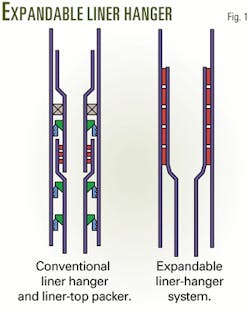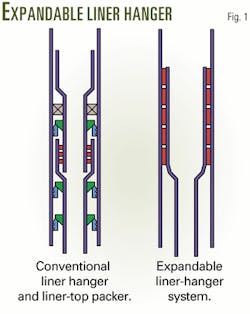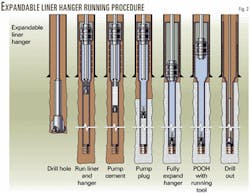Shell Exploration and Production Co., Houston, recently installed the world's first expandable liner hanger (ELH) system in a field trial well in South Texas.
Enventure Global Technology LLC's 75/8 in. ELH was run in 95/8 in., 53.5 lbm/ft casing and 9.5 ppg water-based mud for functional testing in the Hinojosa 8 well in the Fandango field, Zapata County, Tex.
Once the rig crew had run the 75/8 in. expandable liner hanger system, it was expanded or set and the resulting liner lap pressure-tested to 3,800 psi for 45 min.
The ELH system combines the functional requirements of a mechanical liner hanger and liner-top packer, eliminating installation complexity and the need for costly liner-top squeezes, according to Shell.
The integral one-piece design of the ELH provides a slim hanger profile during cementing. It also provides a seal length that is two or three times greater than a conventional liner hanger, resulting in a superior hydraulic seal that minimizes potential leak paths (Fig. 1).
The combination of metal-to-metal and elastomer-to-metal contacts created during the liner expansion produces a robust reliable seal with a high load capacity.
ELH field results have produced annular sealing capabilities of 5,000 psi differential pressure with gas, burst and collapse pressure ratings of 7,000 and 4,000 psi, respectively, and a load-carrying capacity of 425,000 lbf at 300°F.
Fig. 2 shows the ELH deployment procedure for the case of a cemented liner, even though cement was not used for the completion system run in Hinojosa 8.
Typically, crews run the liner to setting depth and pump cement if required. Technicians then use the expansion tool and expand the liner hanger from the top downward, using hydraulic pressure pumped through the drill pipe or deployment string.
Once the ELH is fully set, the expansion tool is removed, leaving only the expanded liner hanger.
Screen completion system
Shell used well Hinojosa 8 to function test a second but unrelated expandable technology. The Halliburton Energy Services Inc. PoroFlex expandable screen completion system was run below the liner hanger.
Fig. 3 shows a schematic of the 160-ft screen assembly, consisting of three joints of screen and one joint of blank spacer pipe. Expandable threaded connections allowed standard make-up.
Technicians expanded the screen assembly from the screen expansion launcher downwards in a separate operation from the liner hanger. It had a run-in OD of 5.375 in. and was expanded to a final OD of 6.125 in.
The expansion pressure for the screen and spacer pipe was in the range 3,600-4,200 psi, as planned. Screen and spacer pipe expansion was confirmed with post-expansion logs.
Operators can employ either weight-down or hydraulic expansion of the screen liner system using the same proprietary expansion tool.
Shell believes expandable screen completions can provide several advantages:
- The larger ID, compared to non-expanded liner or screen, results in lower pressure drop at high fluid flow rates along the producing interval.
- The expanded screen can provide direct support to the open hole, minimizing sand screen plugging from formation collapse.
- A perforated solid base pipe provides high screen burst and collapse ratings.
- The expanded screen can reduce plugging and subsequent erosion damage to non-plugged sections of the screen, which can lead to improved, long-term sand control.
- The expandable screen can eliminate the need for gravel packing, under the right reservoir or formation conditions.





